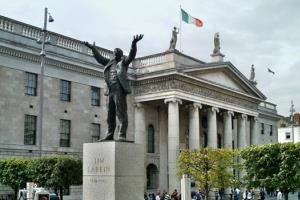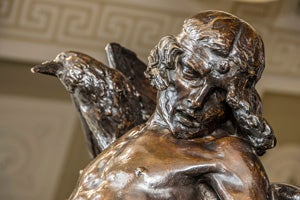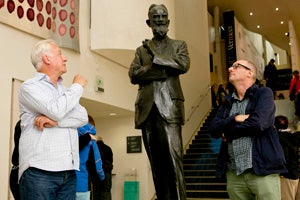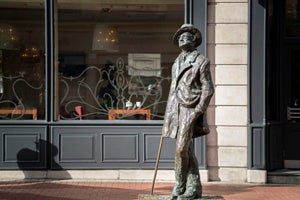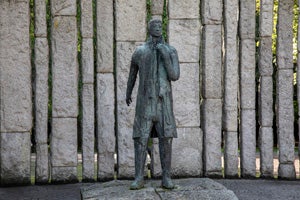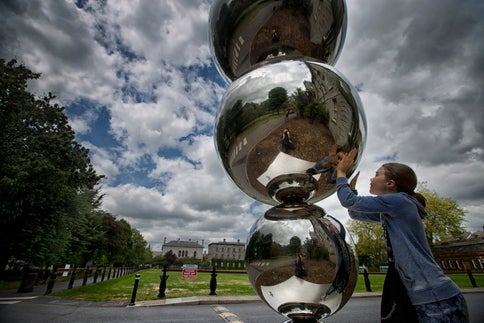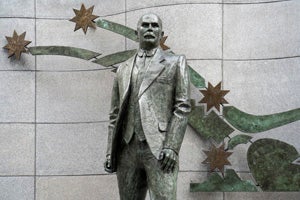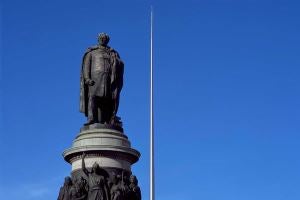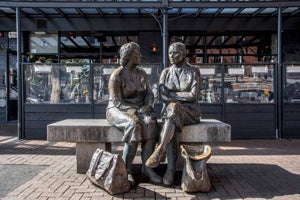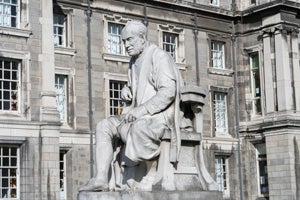- Home
- Things to see & do
- Tours
- Dublin's Talking Statues
Dublin's Talking Statues
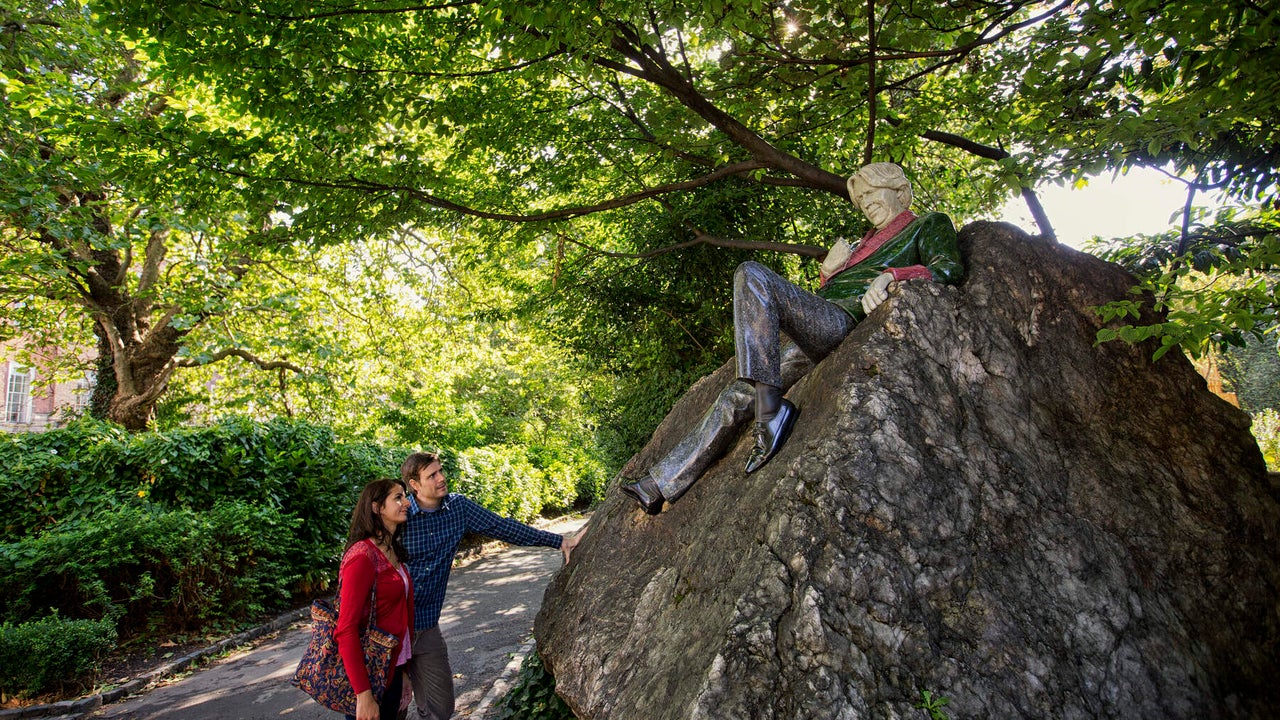
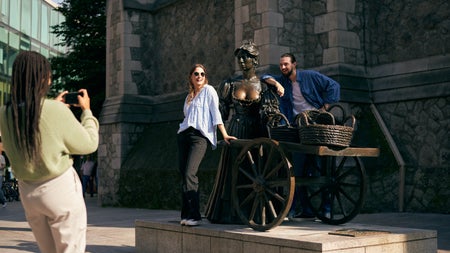
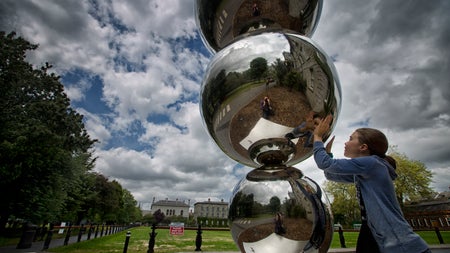
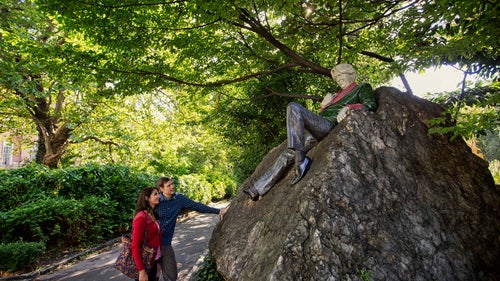
- Linear trail
- Easy trail
- 2 hours
- Audio Guides
Using drama, humour and technology, Talking Statues breathes new life into the sculptured landmarks that surround us. Some approaches are dramatic, others comic and others flights of pure fantasy — all aim to persuade us to look at the statues with new eyes. All you'll need to do is click into the interactive map and follow along with the audio guide for each stop. Each statue has their own tale to recount, and together, they tell Dublin's magnificent story.
James Joyce Statue
The voice of this statue of Ireland's most famous literary icon, James Joyce, has been written by Roddy Doyle and voiced by Gabriel Byrne. Born in Rathgar in 1882, Joyce spent much of his adult life living abroad, but always placed Dublin at the centre of his writing — so it only makes sense his statue, designed by Marjorie Fitzgibbon, remains in the heart of Dublin’s city centre.
George Bernard Shaw Statue
This striking statue of writer George Bernard Shaw was sculpted by his great friend Paolo Troubetzkoy. Shaw’s famous words about the importance of the arts feature on the wall behind — appropriate considering the proximity of the National Gallery of Ireland.
Meeting Place Statue
Meeting Place was sculpted by Jackie McKenna and unveiled in 1988, the year of Dublin’s Millennium celebrations. Affectionately nicknamed ‘The Hags with the Bags’, Meeting Place’s story was written by Rachel Kilfeather and spoken by actor Brenda Fricker.
James Connolly Statue
The Scottish-born socialist and Republican James Connolly is revered for his commitment to raising the standard of living for those in impoverished conditions. His statue is located beneath the imposing Loopline Bridge in Dublin, while its story is written and spoken by Brendan O’Carroll.
Oscar Wilde Statue
Internationally renowned and infinitely quotable, the great writer Oscar Wilde has always been celebrated for his devil-may-care attitude — captured so colourfully in Danny Osborne’s much-loved statue. Oscar reclines on a quartz boulder (sourced in the Wicklow Mountains), while his words are written by author John Banville and spoken by Andrew Scott.
Wolfe Tone Statue
The great revolutionary, immortalised in rousing song, may have been a diminutive man in height — but you would never know that from Edward Delaney’s magnificent 1964 statue. Wolfe Tone's story is written by author Patrick McCabe and spoken by actor Brendan Gleeson.
Jim Larkin Statue
One of Ireland’s greatest champions of workers’ rights, Jim Larkin was present during the 1913 Strike and Lockout. Oisin Kelly’s 1980 statue sees the great trade unionist in typically combative mode. His words are written by Enda Walsh and spoken by Stephen Rea.
Cú Chulainn Statue
The General Post Office (GPO) building (which housed the rebels during the 1916 Easter Rising) is a suitably grand public space in which to showcase Oliver Sheppard’s 1935 statue, The Death of Cú Chulainn. His story is written by Eoin Colfer and spoken by Peter Coonan.
George Salmon Statue
George Salmon was a professor of mathematics for many years, as well as a Church of Ireland rector. As provost of Trinity College Dublin, Ireland’s oldest university, he presided over its tri-centenary celebrations in 1892. His statue's words are written and spoken by Joe Duffy.
Angel Fidelity Statue
The graceful (yet mysterious) winged figure of Fidelity sits in the middle part of the famous Daniel O'Connell monument (designed by John Henry Foley), along with Patriotism, Courage and Eloquence. Her piece is written by Paula Meehan and spoken by actor Ruth Negga.
Molly Malone Statue
Molly Malone is a popular old Dublin folk song, telling the story of a young fishmonger who trades on the streets of Dublin and sadly dies of fever. While the figure of Molly is fictional, the song contains elements of true historical significance – and her statue has become the most photographed in Dublin today.
- Jim LarkinThings to see & doStatues & monuments
- Cú ChulainnThings to see & doStatues & monuments
- George Bernard ShawThings to see & doStatues & monuments
- James JoyceThings to see & doStatues & monuments
- Wolfe ToneThings to see & doStatues & monuments
- Apples & Atoms Sculpture, Trinity CollegeThings to see & doStatues & monuments
- Molly MaloneThings to see & doStatues & monuments
- James ConnollyThings to see & doStatues & monuments
- Oscar WildeThings to see & doStatues & monuments
- Daniel O'Connell MonumentThings to see & doStatues & monuments
- Meeting PlaceThings to see & doStatues & monuments
- George SalmonThings to see & doStatues & monuments
